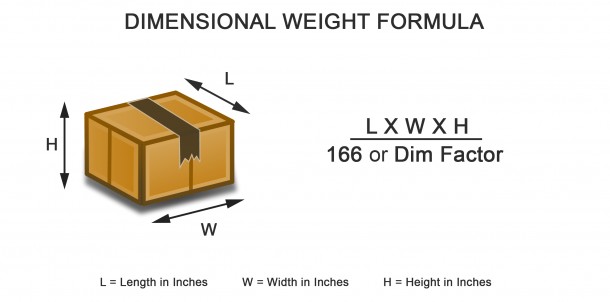Dimensional weight, also known as volumetric weight, is a weight assigned to a package which takes into account the size of the package. Dimensional weight is used in calculating the cost of shipping with both FedEx and UPS and has caused companies shipping large, light weight, boxes to see considerable increases in their shipping cost since 2014. In short, the dimensional weight of a package is a simple formula, taking the package’s volume divided by a carrier and contract specific number often called the “Dim Factor”. The longer story is, that dimensional weight represents a large challenge for many shippers.
A Bit of History
Dimensional weight pricing is not a new concept. FedEx and UPS have been using dimensional weight pricing for air and international packages for years due to space on planes having always been a premium. Beginning in 2015 however, UPS and FedEx expanded their use of dimensional weight pricing to calculate charges for all packages. The reasoning behind this change has a lot to do with consumer trends. With the rise of eCommerce, a greater and greater strain has been placed the major carriers’ truck capacities as more and more people order their products online. Much of these products ordered online have been relatively light items that take up considerable space in trucks, such as clothing and shoes. Aside from the carriers expanding their truck fleets to keep up with this demand, it began to make sense to switch pricing models from just focusing on the weight to a model which also takes into account the size of the packaged shipped. The easiest way to do this was to expand their existing pricing strategy for international shipments to all shipments which brings us to the current situation where dimensional weight is used throughout FedEx’s and UPS’s small parcel shipping.
FedEx and UPS Dimensional Weight Formula
For both UPS and FedEx, the dimensional weight of a package is calculated by taking the length x height x width of a package and then dividing that number by a denominator called the “dim factor”. This dim factor can be negotiated as part of your contract negotiation process, but each carrier has a default dim factor denominator of 166. Once the dimensional weight of the package is calculated, it is compared against the actual weight of the package and whichever is higher is used to determine the shipping price.

Example
Let’s walk through an example. Say you are shipping a 2 pound inflated basketball. To do this, you would take the packaged basketball’s measurements of 12 in x 12 in x 12 in, multiply them together to get 1728 cubic inches and then divide that number by the dim factor of 166. The resulting dimensional weight would be 10.4 pounds, which would then be rounded up to 11 and compared to the actual weight of 2 pounds. You are now going to be charged for an 11 pound shipment instead of a 2 pound shipment which you would have been charged for before 2015. This result is a considerable price increase but one which reflects the amount of space which the package is going to take up in the carrier’s truck.
The Big Picture
So, why does UPS and FedEx use dimensional weight? It is a pretty simple reason. It is to keep them from losing money on large, lightweight items, a category of shipments which has seen a substantial increase due to online sales of clothing, shoes and inefficient packaging. Space in a truck is limited and the carriers want to make sure they are being compensated for that space, not just the weight which they are transporting. Furthermore, it provides an incentive for shippers of goods to be efficient with their box sizes.
Because of the clear problems with only considering weight when calculating the cost of shipping a package and trends towards online sales of light but bulky items, FedEx and UPS decided to expand the pricing model they had used on air shipments, which accounts for space as well as weight, to all of their shipments. While this impact may seem abstract, we have seen clients of UPS and FedEx whose small package costs have gone up over 20% since 2014 due to the implementation of dimensional weight pricing on ground packages.
What Can be Done?
- Reduce your box size. Shipping empty space costs you money and is just not good practice. Look at adding more box sizes to your fulfillment process or look at companies such Packsize who can help you make order specific boxes
- Make sure FedEx and UPS are correctly measuring your boxes and not incorrectly overcharging you. Lamprey Systems has cutting edge no cost auditing solutions which track UPS and FedEx errors and automatically obtain your business any refunds owed
- Negotiate your dim factor. Odds are your company didn’t pay much attention to its dim factor at the last negotiation. Lamprey Systems has helped 100’s of clients negotiate their carrier contracts, saving clients on average 15% a year on their shipping spend





